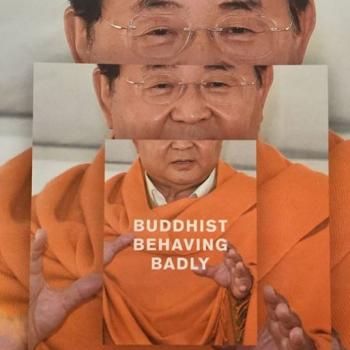‘Tis my great honor to host NellaLou from Smiling Buddha Cabaret, with this post exploring the buddhoblogosphere… Read on:
Thank you to Justin for allowing me to use the cyberspace he has created on American Buddhist Perspective and to Nate from Precious Metal for the blog-swap idea and for administering the exercise. The assigned topic is “The impact/ importance of the buddhoblogosphere? Too many blogs? Not enough?” This post is inspired by the Avatamsaka Sutra.
Introduction
A Canadian writer, living in India, writing a piece for a blog called American Buddhist Perspective is in itself a statement of the fulfillment of the potential of modern communications technology to transcend boundaries.
Blogs about Buddhism are written in languages such as Romanian, Finnish, Hindi , Spanish, Thai, Danish and many others.
Although the Internet landscape is changing rapidly, from my brief survey at present the majority of Buddhist oriented blogs seem to be related to the Zen tradition. This is somewhat ironic, since popular views of Zen would have silence, emptiness and “do not rely on words and letters” as Bodhidharma conveyed, and Eisai also stated ” The Zen School is independent of what is articulated in names and words”, as the point of view.
But that is only a portion of the story from the Zen perspective. Others have expressed views that amplify and explain.
Some History
In an interview from 2006 that appears on Brad Warner’s blog Gudo Nishijima Roshi is asked:
18. What can we understand with words, and what can we not understand with words?
We can understand everything, but at the same time, our understandings can never touch Reality.
Early masters wrote in The Transmission Of The Lamp
The original truth has no name,
But by name the truth is made manifest.
When the true dharma is obtained,
There is neither truth nor falsehood.Sohaku Ogata trans
Shih-shuang said:
There is originally no word for truth, but the way to it is revealed by words. The way originally has no explanation, but reality is made by explanation. That is why the buddhas appeared in the world with many expedient methods; the whole canon dispenses medicines according to diseases.
Zen Teachings, Cleary trans.
The biographer and principal disciple of Hakuin, Torei wrote about Hakuin:
The words and sayings of the Zen masters never left his side. He used them to illuminate the old teachings by means of the mind, to illuminate the mind by means of the old teachings.
Hakuin on Kensho trans. and commentary by Albert Low
It then appears that words and names do have their place within the Zen context.
But it is Hakuin himself that deemed writing to be:
…the exercise of verbal prajna (Low)
Prajna means “the unaroused, unobstructed mind” according to Low.
Consider the point that an editor has made in the Wikipedia entry on prajna.
The beginning of the Heart Sutra includes the phrase “.doing Prajña.” indicating that prajña is also an activity as well as an outcome, quality or state.
The concurrence with Hakuin’s “exercise” is interesting.
Writing as an activity produces a direct product of the mind that allows one to examine both the content and processes of the mind. Ultimately, in time, or concurrently, if one is able to view the depth of the words in that way, these are both surpassed and the Paramita-Perfection of the Mind is experienced.
Words are then Upaya (skillful means) as is everything else depending upon intention, awareness and use. Whether soft or loud, they can point, reveal, suggest, name, indicate and direct towards Truth.
At Present-Some Objections and their Resolution
There are some doubts about Buddhism and Internet interaction due to lack of context and additional communication cues like facial expression. Consider though, that this volume of information is often compensated for on the Internet with the addition of images such as photos, videos or emoticons, sounds such as links to music and voice files like recorded dharma talks and informational links to broaden the scope of the point and the context of the writer. It is of a more cerebral nature due to the technology yet still harkens back to the sensory, particularly visual realm.
And also consider the relevance of Buddhist texts throughout history. Monks and others went to great lengths to obtain texts including making journeys, usually on foot, for hundreds or thousands of miles and further to preserve texts during times of Buddhist persecution. The clandestine removal of thousands of texts from Tibet during the Chinese invasion and current occupation is one recent example. Had this not been undertaken they likely would have been destroyed during the Cultural Revolution.
One cannot ascertain the author’s stature, gait, eating habits, facial expressions, tone of voice or other sensory information from the texts. Yet the words, as symbols for the profound concepts to which they point are still valued millennia later.
Another aspect that has been brought up in the Internet and Buddhism interaction has to do with the nature of the Internet itself. Often personal projects on the Internet are fraught with self-indulgent vanity and egocentric exhibitionism. From the blog 21Awake, Rohan Gunatillake brings up this point and a suggests a counterpoint to it’s resolution.
“Blogs and social networking platforms such as Facebook and mySpace are often criticised for being fuelled by vanity, or the hunger to be seen….Inherent in all social web activity, including the buddhoblogosphere, is not only a sense of wanting to be seen as a somebody or a response to the pervasive loneliness of modern life. Running through those very same veins of motivation is a recognition of the interconnection we share with others and a wish to honour that connection.” Bhava tanha and the buddhoblogosphere from 21 Awake
Rohan’s point is well taken here. In fact, it was what provided a turning point for my thinking as I was preparing this post. Consciously or sub-consciously, the desire to be noticed, to have one’s words read, to put forth opinion, to best others, to be seen as an authority or win “the best Buddhist” award, if such award existed, may all contribute to one’s reasoning process in starting up or continuing a blog. One may begin a blog about anything, even Buddhism for the most vain and shallow reasons. Just as one may begin a Buddhist practice for similar reasons.
That motivation, that craving (tanha) interestingly enough, in the Internet and Buddhism context, can become a transformative element in Buddhist practice. Craving itself becomes a skillful means by which the Buddhadharma is engaged more fully and understanding deepened.
Interaction is instructive. The public nature of presentations on the Internet provokes interaction and allows a person to connect with others. That the connection may be pleasant or unpleasant is not so important as the dharmic content of messages that are exchanged. In time one learns the true meaning of equanimity.
The interconnection, in the presence of the Buddhadharma seems to work as something of a “stone polisher” for Buddhist practice on the Internet. Gradually eroding original ego-based intentions into something more broad and inclusive.
Robert Thurman said in the TED talk entitled Becoming Buddha on the Web:
This interconnection, this forging of a mass awareness of where everybody can really know everything that’s going on everywhere in the planet and therefore it will become intolerable. What compassion is where it will become intolerable for us…that we sit here in comfort and in pleasure and enjoying the life of the mind or whatever it is and there are people who just absolutely are riddled with disease and they cannot have a bite of food and they have no place or they are being brutalized by some terrible person and so forth. It just becomes intolerable and with all of us knowing everything that we’re all kind of forced by technology to become Buddhas or something, to become enlightened…Compassion is a kind of generosity. Generosity is a lot more fun.
The generosity with words and thoughts, sharing and connection of lives and experiences develops the greater the opportunity to experience interconnection of all beings. So even from a position of tanha the potential of compassion is present in the circumstances. The seeds of dana, generosity, and compassion hidden within, may well find some fertile ground.
As for the Future
Perhaps 100 Zen students with 100 laptops will eventually come up with Shobogenzo. And perhaps not.
Perhaps entirely new Buddhist classic texts will emerge.
Or perhaps, as Necroichthus wrote on Twitter:
So the qwerty keyboard is in fact the path to enlightenment encoded in little plastic buttons? Who knew?











